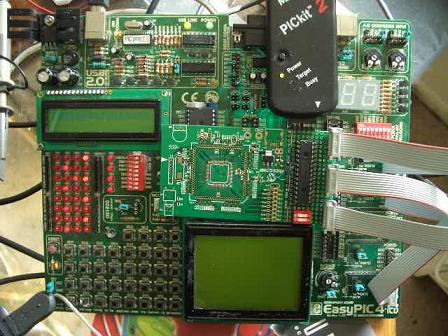I have used 3.3V PIC's (including 16-bit devices such as the PIC24 in the picture) with an EasyPIC4.

I have used 3.3V PIC's (including 16-bit devices such as the PIC24 in the picture) with an EasyPIC4.

Thanks guys. It looks like the MC34063A switching regulator allows down to 3 volts with a change of voltage adjustment resistors R56 and R55. Also looks like most chips on the board might also be 3v tolerant. I'll have to look at it some more. Don't know if the lcd's will work at 3.3v though. Hopefully enough functionality in the rest of the board to get by. What did you find out rmteo? Is this what you did, or are you powering it directly from the pickit2?
Walter
Last edited by ScaleRobotics; - 24th April 2010 at 07:09.
Both the LCD and GLCD work with 3.3V input signals - the LEDs will be a little dimmer as the PIC sources current to them. As long as the external PIC is powered by its own separate supply (3.3V from the PicKIT2 in my case) and share a common ground, most of the peripherals on the EasyPIC work fine. The EasyPIC is powered by its own on-board 5V supply. I have also tried UART communications between the on-board 5V PIC and the external 3.3V PIC and it works.
Obviously, the external PIC will need to be programmed (and/or debugged) using something like a PicKIT2 (and the appropriate development software). PicFLASH does not support 3.3V only devices. As mentioned previously, this technique allows you to work with other devices such as PIC24/dsPIC33 besides 8-bit PIC's on the EasyPIC. In fact, I have tested this with 32-bit MCU's from NXP and ST as well.
Last edited by rmteo; - 24th April 2010 at 15:15.
Bookmarks